
What are the taxation process and section applicable for following two cases mentioned below: –
Case 1: Company Issues ESOPs Without Consideration
Case 2: Company Issues ESOPs at a Discount
Covering both the scenarios mentioned above (issued without consideration or at a discount). The tax treatment is fundamentally the same for both cases.
The taxation of ESOPs is a two-stage process:
- At the time of exercising the options (when the employee converts the options into actual shares).
- At the time of selling the shares (when the employee sells the shares on the market).
Stage 1: Taxation as a Perquisite (at the time of Exercise)
This is the first tax event and it’s the same regardless of whether the ESOPs were granted at a discount or free of cost.
Legal Provision: This is covered under Section 17(2)(vi) of the Income Tax Act, 1961. This section defines a “perquisite” to include the value of any specified security or sweat equity shares allotted or transferred to an employee by the employer, free of cost or at a concessional rate.
Computation Method: The taxable amount is the difference between the Fair Market Value (FMV) of the shares on the date of exercise and the exercise price paid by the employee. This amount is treated as a perquisite and added to the employee’s “Salary” income for that financial year. The employee is then taxed on this total income according to their applicable income tax slab rates.
- Case 1 – Issued without Consideration: Where the exercise price is NIL, the entire Fair Market Value (FMV) of the shares on the date of exercise, as determined under Rule 3(8) of the Income-tax Rules, 1962, shall be treated as a taxable perquisite under Section 17(2)(vi) of the Income-tax Act, 1961, and included in the employee’s salary income.
- Taxable Perquisite = FMV on exercise date – ₹0
- Case 2 (Issued at a discount): The exercise price is the discounted price paid by the employee. The taxable perquisite is the difference between the FMV and this discounted price.
- Taxable Perquisite = FMV on exercise date – Discounted Exercise Price
This perquisite will be added to the employee’s salary income for the financial year and taxed at their slab rate. The employer is obligated to deduct TDS (Tax Deducted at Source) as per Section 192 on this amount.
Special Provision for Eligible Startups-
To provide relief to employees of eligible startups (registered with the Department for Promotion of Industry and Internal Trade), the tax payment on the perquisite can be deferred. The TDS u/s 192(1C) on the perquisite is payable at the earliest of the following dates:
- The expiry of 48 months from the end of the relevant assessment year in which the options were exercised.
- The date of sale of the shares by the employee.
- The date the employee ceases to be an employee of the company.
Stage 2: Taxation as a Capital Gain (at the time of Sale)
This second tax event occurs when the employee sells the shares they acquired by exercising the ESOPs. The gain or loss is taxed as a Capital Gain.
Computation Method: The capital gain is calculated on the difference between the selling price and the Fair Market Value (FMV) on the date of exercise. The FMV on the exercise date acts as the “cost of acquisition” for the purpose of calculating capital gains.
As per section 49(2AA) Where the capital gain arises from the transfer of specified security or sweat equity shares referred to in sub-clause (vi) of clause (2) of section 17, the cost of acquisition of such security or shares shall be the fair market value which has been taken into account for the purposes of the said sub-clause.
- Capital Gain = Sale Price – FMV on Exercise Date
The tax rate depends on the holding period of the shares, which starts from the date of allotment of actual shares (not the date of option grant) to the date of sale. The classification of the shares as “listed” or “unlisted” also impacts the holding period and tax rates.
A. For Listed Shares
- Short-Term Capital Gain (STCG): If the shares are sold within 12 months of the exercise date. STCG is taxed at a flat rate of 15% under Section 111A.
- Long-Term Capital Gain (LTCG): If the shares are held for more than 12 months. LTCG is taxed at 10% on gains exceeding ₹1 lakh in a financial year, with no indexation benefit.
B. For Unlisted Shares
- Short-Term Capital Gain (STCG): If the shares are sold within 24 months of the exercise date. The gain is added to the employee’s total income and taxed at their applicable income tax slab rates.
- Long-Term Capital Gain (LTCG): If the shares are held for more than 24 months. LTCG is taxed at a flat rate of 20% with the benefit of indexation.
Summary Table of ESOP Taxation
| Stage of ESOP | Section of Income Tax Act | Taxable Amount | Tax Rate |
| At Exercise (Allotment of shares) | Section 17(2)(vi) | FMV on exercise date – Exercise price | As per employee’s slab rates (taxed as ‘Salary’ income) |
| At Sale (Selling the shares) | Section 111A, 112A, or normal slab rates | Sale price – FMV on exercise date | Dependent on holding period and whether shares are listed or unlisted |
Disclaimer: This article provides a general overview of ESOP taxation in India as per the Income-tax Act, 1961. It is intended for informational purposes only and should not be construed as professional advice. Readers should consult a qualified tax advisor for guidance specific to their circumstances.
Author
Mr. Ayush Dev
Intern
Pavan Goyal and Associates (Chartered Accountants)
Office No. B212, GO Square, Mankar Chowk, Wakad, Pune 411057
Email – office@goyalca.com
Contact – 9762763351